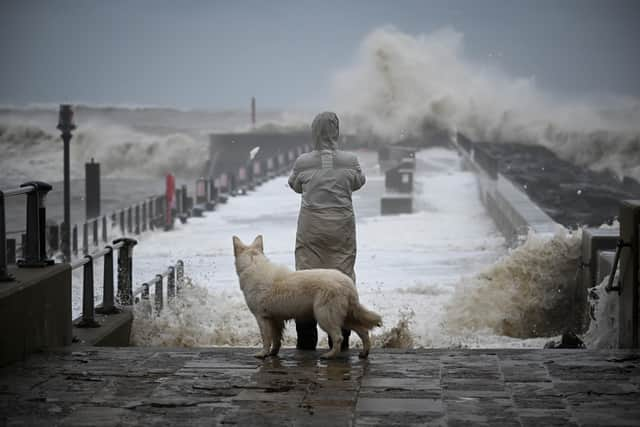How do you pronounce Ciaran? Met Office storm name explained as UK weather forces school closures
and live on Freeview channel 276
Gusts of over 100 mph have resulted in travel chaos, the closure of schools and thousands of homes without electricity after Storm Ciarán pummelled the south of England and the Channel Islands.
Some Jersey residents were forced to flee their homes due to property damage, and one woman claimed that hailstones "bigger than a golf ball" had broken her windows.
Advertisement
Hide AdAdvertisement
Hide AdDue to the potential risk to students, hundreds of schools in the south of England were forced to close on Thursday (2 November), while the anticipated strain on local services in Hampshire and the Isle of Wight prompted the declaration of a major incident.
Flooding is expected in 73 areas, according to the Environment Agency, most of which are on the south coast of England. A further 182 alerts are in place for possible flooding across England.
But why exactly is the latest storm called Storm Ciarán, and what does the name mean? Here is everything you need to know about it,
Why does the Met Office name storms?


The Met Office names storms for a few important reasons. Perhaps most pressingly, giving storms names helps raise public awareness about the potential impact and severity of a particular weather event.
Advertisement
Hide AdAdvertisement
Hide AdWhen a storm is named, it becomes easier for the general public to follow weather forecasts and warnings. People are more likely to pay attention to and take action based on forecasts when they can refer to a named storm.
Naming storms also facilitates more effective communication between meteorologists, the media and the public, and simplifies the process of conveying information about multiple storms occurring simultaneously or in close succession.
When storms are named, it encourages people to take necessary precautions and prepare for severe weather, and can help reduce the risk of harm to individuals and property, as well as minimise the societal and economic impacts of storms.
Naming storms creates a historical record of significant weather events, which makes it easier to reference and study past storms, including their frequency, intensity and impacts, which can be valuable for research and analysis.
Why was it named Storm Ciarán?
Advertisement
Hide AdAdvertisement
Hide AdThe deep area of low pressure which became Storm Ciarán was officially given its name by the UK Met Office on Sunday 29 October.
The Met Office collaborates with Met Éireann in Ireland and KNMI in the Netherlands to assign names to storms. 2023 marks the ninth consecutive year in which storms have been given official names.
The contributions made by the Met Office to the list encompass both public submissions and the names of individuals who have been part of the response efforts during severe weather events.
Ciarán was put forward by the public, but it also happens to be the name of Ciarán Fearon, who is employed within the Department for Infrastructure in Northern Ireland.
What does Ciarán mean?
Advertisement
Hide AdAdvertisement
Hide AdThe name Ciarán is of Irish and Gaelic origin, and is a traditional Irish name for boys. Ciarán is derived from the Gaelic word "ciar," which means "dark" or "black." Therefore, Ciarán can be interpreted to mean "dark-haired" or "black-haired."
It's a popular name in Ireland and has historical and cultural significance in Irish tradition. The name is closely associated with various saints and historical figures in Irish history.
How do you pronounce Ciarán?
Ciarán is typically pronounced as "KEER-awn" in Irish and Northern Irish contexts. "Cia" is pronounced like "KEE" with the "C" making a soft "K" sound, similar to the "k" in the word "key."
"ran" is pronounced like "rawn," with the "r" being pronounced with a slight roll or tap of the tongue.
So, when you put it all together, it's "KEER-awn." The pronunciation may vary slightly based on regional accents and dialects, but the general pronunciation is as described.
Comment Guidelines
National World encourages reader discussion on our stories. User feedback, insights and back-and-forth exchanges add a rich layer of context to reporting. Please review our Community Guidelines before commenting.
